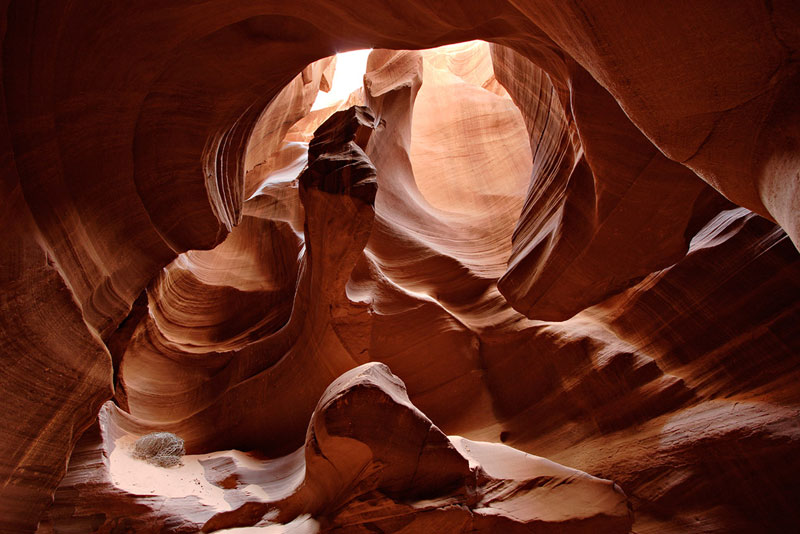
Located on Navajo land near Page, Arizona, Antelope Canyon is an incredible place where water and time have eroded the rock and turned it into a slot canyon. The result is an incredible formation of smooth, flowing rock. In 1997 the Navajo Tribe turned the area into a Navajo Tribal Park, opening up Antelope Canyon for tourism.
Below you will find a gallery of this beautiful place along with travel information and a brief history of its formation.
Geology
Antelope Canyon was formed by erosion of Navajo Sandstone, primarily due to flash flooding and secondarily due to other sub-aerial processes.
Navajo Sandstone is a geologic formation that is spread across the U.S. states of southern Nevada, northern Arizona, northwest Colorado, and Utah. The formation is particularly prominent in southern Utah, where it forms the main attractions of a number of national parks and monuments including Red Rock Canyon National Conservation Area, Zion National Park, Capitol Reef National Park, Glen Canyon National Recreation Area, Grand Staircase-Escalante National Monument, and Canyonlands National Park. [Source]
At Antelope Canyon, rainwater, especially during monsoon season, runs into the extensive basin above the slot canyon sections, picking up speed and sand as it rushes into the narrow passageways. Over time the passageways are eroded away, making the corridors deeper and smoothing hard edges in such a way as to form characteristic ‘flowing’ shapes in the rock. Flooding in the canyon still occurs. [Source]
Upper Antelope Canyon
Upper Antelope Canyon is called Tsé bighánílíní, “the place where water runs through rocks” by the Navajo. It is the most frequently visited by tourists for two reasons. First, its entrance and entire length are at ground level so no climbing is required. Second, beams (shafts of direct sunlight radiating down from openings in the top of the canyon) are much more common in Upper than in Lower.
Beams occur most often in the summer months, as they require the sun to be high in the sky. Winter colors tend to be a little more muted. Light beams start to peek into the canyon around March 15 and disappear by October 7 each year. [Source]
Upper Antelope is at about 4,000 feet elevation and the canyon walls rise 120 feet above the streambed. It is entirely located within the LeChee Chapter of the Navajo Nation. [Source]
Lower Antelope Canyon
Lower Antelope Canyon, called Hazdistazí, or “spiral rock arches” by the Navajo, is located a few kilometers from Upper Antelope. Prior to the installation of metal stairways, visiting the canyon required climbing along pre-installed ladders in certain areas. Even following the installation of stairways, it is a more difficult hike than Upper Antelope—it is longer, narrower in spots, and even footing is not available in all areas. At the end, the climb out requires several flights of stairs.
Despite these limitations, Lower Antelope Canyon draws a considerable number of photographers, though casual sightseers are much less common there than in Upper. The lower canyon is in the shape of a “V” and shallower than the Upper Antelope. Lighting is better in the early hours and late afternoon. [Source]
Visiting Antelope Canyon
– The road to Antelope Canyon is gated by the Navajo Nation and entry is restricted to guided tours led by authorized tour guides
– Cost per person typically ranges from $30-$80 USD. A list of authorized guides can be found here
– As of May 1, 2011, a 2-hour time limit was instated for each section (Upper and Lower)
– Flash floods are a safety risk when visiting Antelope Canyon. Ladder systems are now bolted in place, cargo nets are installed at the top of the canyon, and there is an alarm horn to warn of any dangers
– To visit Antelope Canyon, begin your journey in Page, Arizona
– For more information visit the official website
If you enjoyed this post, the Sifter
highly recommends: